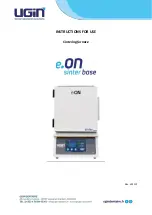
292451-UUM-A-0108
6
Unitary Products Group
Cleaning the Secondary Heat Exchanger
1.
Follow steps 1 - 7 under cleaning the Heat Exchanger.
2.
Remove the vent piping from the vent blower housing. Disconnect
the drain lines from the vent blower housing and from the conden-
sate drain pan. Remove the vent blower housing blower and the
condensate pan.
3.
Using a stiff wire brush, remove the loose scale or soot from each
tube.
4.
Vacuum the secondary heat exchanger.
5.
Finish the cleaning procedure by following steps 9 - 11 under
cleaning the Heat Exchanger.
Cleaning the Vent / Air Intake System
Should it be necessary to service the vent / air intake system, the man-
ufacturer recommends this service be conducted by a qualified service
agency.
The operation of this appliance requires the reassembly and resealing
of the vent / air intake system as specified in the
“Combustion Air and
Vent System”
located in the Installation Manual.
NORMAL OPERATION SEQUENCE
The furnace control calculates the optimum firing rate each time the wall
thermostat R and W contacts close or open (at the beginning and at the
end of each call for heat) based on information from the thermostat and
past demand. UNLIKE CONVENTIONAL SYSTEMS, THE WALL
THERMOSTAT DOES NOT SIMPLY TURN THE FURNACE ON AND
OFF. THE FURNACE CONTROL CALCULATES THE DEMAND AND
MAY CONTINUE TO FIRE THE FURNACE DURING PORTIONS OF
THE THERMOSTAT "OFF" CYCLE.
When the wall thermostat R and W contacts close, indicating a call for
heat, the following sequence occurs:
1.
The inducer is energized and ramps up its speed until airflow is
proven by the pressure switch and by the pressure sensor on the
control board.
2.
The hot surface ignitor is energized.
3.
After a 17-20 second igniter heatup, the gas valve opens and the
burners light.
4.
When the control senses that flame is present, the circulating
blower starts at low speed.
5.
The furnace fires at 70% of full rate for 30-45 seconds, then drops
to the minimum (35%) firing rate.
6.
The firing rate is automatically adjusted to meet demand, increas-
ing gradually to maximum (100%) firing rate if the thermostat is not
satisfied within a defined time.
7.
When the thermostat R and W contacts open (thermostat is satis-
fied) the furnace control recalculates the demand and a new firing
rate.
a.
If demand exceeds the minimum firing rate, the burners will
continue to fire at a recalculated reduced firing rate, decreas-
ing if the thermostat remains off for a defined time.
b.
If demand does not exceed the minimum firing rate, the burn-
ers will shut off immediately.
8.
After the burners shut off, the circulating blower will continue to run
until the temperature sensor detects that the supply air tempera-
ture has dropped to the desired level, which should take from 30 to
90 seconds.
ADJUSTMENT OF FAN CONTROL SETTINGS
Cooling -
The airflow delivered by the furnace during cooling operation
can be adjusted to match the cooling capacity of the A/C condensing
unit. This is done by moving the COOL jumper on the control board to
give the desired airflow.
Do not move the motor wires to different positions on the
furnace control board!
The jumper has four positions, which will deliver sufficient airflow in
cooling mode for the cooling capacities shown in the table below. The
CFM delivery on each jumper position is shown in Table 2.
Continuous Fan Operation -
The airflow delivered by the furnace dur-
ing continuous fan operation can be adjusted as desired. This is done
my moving the FAN jumper on the control board to give the desired air-
flow.
Do not move the motor wires to different positions on the
furnace control board!
The jumper has three positions. The "A" position delivers maximum air-
flow, 100% of the blower capacity. Position "B" delivers approximately
70% of the blower capacity. And Position "C" delivers minimum airflow,
approximately 40% of the blower capacity.
Hot Surface Ignition System
TABLE 2:
Cooling Airflow - A/C Capacity in Tons
Models
Jumper Position
D
C
B
A
60/1200
1-1/2
2
2-1/2
3
80/1200
1-1/2
2
2-1/2
3
80/1600
2-1/2
3
3-1/2
4
100/1600
2-1/2
3
3-1/2
4
100/2000
3
3-1/2
4
5
120/2000
3
3-1/2
4
5
FIGURE 8:
Furnace Control Board
HOT SURFACE IGNITION SYSTEM
Do not attempt to light this furnace by hand (with a
match or any other means). There may be a potential
shock hazard from the components of the hot surface
ignition system. The furnace can only be lit automatically
by its hot surface ignition system.
ERROR
TEST
A
B
C
BLOWER
D’AUX
LOW VOLTAGE
TERMINALS
DIAGNOSTIC
LIGHT
TEST
BUTTON
LAST ERROR
BUTTON
CONTINUOUS
FAN SPEED
JUMPER
COOLING
SPEED JUMPER
HUMIDIFIER
TERMINALS
EAC
TERMINALS


























